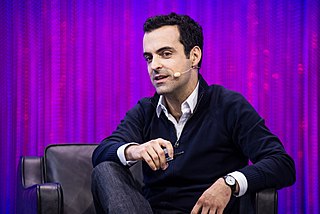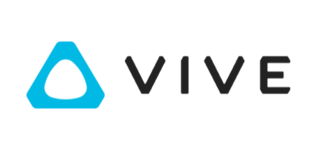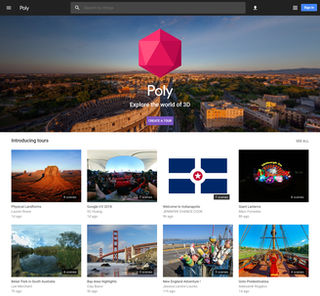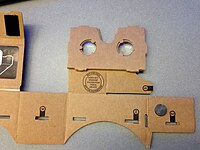
A virtual keyboard is a software component that allows the input of characters without the need for physical keys. The interaction with a virtual keyboard happens mostly via a touchscreen interface, but can also take place in a different form when in virtual or augmented reality.

360-degree videos, also known as surround video, or immersive videos or spherical videos, are video recordings where a view in every direction is recorded at the same time, shot using an omnidirectional camera or a collection of cameras. The term 360x180 can be used to indicate 360° of azimuth and 180° from nadir to zenith. During playback on normal flat display the viewer has control of the viewing direction like a panorama. It can also be played on a display or projectors arranged in a sphere or some part of a sphere.
Android is a mobile operating system based on a modified version of the Linux kernel and other open-source software, designed primarily for touchscreen mobile devices such as smartphones and tablets. Android is developed by a consortium of developers known as the Open Handset Alliance, though its most widely used version is primarily developed by Google. It was unveiled in November 2007, with the first commercial Android device, the HTC Dream, being launched in September 2008.

Oculus Rift is a discontinued line of virtual reality headsets developed and manufactured by Oculus VR, a virtual reality company founded by Palmer Luckey that is widely credited with reviving the virtual reality industry. It was the first virtual reality headset to provide a realistic experience at an accessible price, utilizing novel technology to increase quality and reduce cost by orders of magnitude compared to earlier systems. The first headset in the line was the Oculus Rift DK1, released on March 28, 2013. The last was the Oculus Rift S, discontinued in April 2021.

Sketchfab is a 3D modeling platform website to publish, share, discover, buy and sell 3D, VR and AR content. It provides a viewer based on the WebGL and WebXR technologies that allows users to display 3D models on the web, to be viewed on any mobile browser, desktop browser or Virtual Reality headset.

Tango was an augmented reality computing platform, developed and authored by the Advanced Technology and Projects (ATAP), a skunkworks division of Google. It used computer vision to enable mobile devices, such as smartphones and tablets, to detect their position relative to the world around them without using GPS or other external signals. This allowed application developers to create user experiences that include indoor navigation, 3D mapping, physical space measurement, environmental recognition, augmented reality, and windows into a virtual world.

Hugo Barra is a Brazilian computer scientist, technology executive and entrepreneur. From 2008 to 2013, he worked in a number of product management roles at Google, including vice president and product spokesperson of its Android division. From 2013 to 2017, he worked at Xiaomi as vice president of global operations. From 2017 to 2021, he worked as vice president of Virtual Reality and head of the Oculus division at Meta Platforms. In May 2021, he left Meta to join health technology startup Detect as CEO.

The Samsung Gear VR is a virtual reality headset developed by Samsung Electronics, in collaboration with Oculus VR, and manufactured by Samsung. The headset was released on August 21, 2015.

HTC Vive is a line of virtual and mixed reality headsets produced by HTC Corporation. The brand currently encompasses headsets designed for use with personal computers as well as standalone headsets such as the Vive Focus line, Vive Flow glasses, and the Vive Elite XR mixed reality headset.

Open Source Virtual Reality (OSVR) was an open-source software project that aimed to enable headsets and game controllers from all vendors to be used with any games developed by Razer and Sensics.
LING VR (灵镜) is a brand series founded in 2014 by Beijing VR-TIME Technology Co., Ltd. The goal of LING VR is to bring virtual reality into our life. There are currently two product lines under LING VR: BAI series and HEI. BAI is a virtual reality headset that structurally similar like Google Cardboard and Samsung Gear VR, mounted with smart phones plus a Bluetooth controller to perform complex input. HEI is an all-in-one wireless headset that positioning in experiencing high quality VR worlds and games.

Kubity is a cloud-based 3D communication tool that works on desktop computers, the web, smartphones, tablets, augmented reality gear, and virtual reality glasses. Kubity is powered by several proprietary 3D processing engines including "Paragone" and "Etna" that prepare the 3D file for transfer over mobile devices.

Android Nougat is the seventh major version and 14th original version of the Android operating system. First released as an alpha test version on March 9, 2016, it was officially released on August 22, 2016, with Nexus devices being the first to receive the update. The LG V20 was the first smartphone released with Nougat.

Daydream is a discontinued virtual reality (VR) platform which was developed by Google, primarily for use with a headset into which a smartphone is inserted. It is available for select phones running the Android mobile operating system that meet the platform's software and hardware requirements. Daydream was announced at the Google I/O developer conference in May 2016, and the first headset, the Daydream View, was released on November 10, 2016. To use the platform, users place their phone into the back of a headset, run Daydream-compatible mobile apps, and view content through the viewer's lenses.

Poly was a website created by Google for users to browse, distribute, and download 3D objects. It was launched in 2017 and intended to allow creators to easily share and access 3D objects. It featured a free library containing thousands of 3D objects for use in virtual reality and augmented reality applications. On December 2, 2020, it was announced that Poly would be shutting down on June 30, 2021, with the ability to upload 3D models to be suspended on April 30, 2021.

vTime XR is a free-to-play virtual reality and augmented reality social network created by British virtual and augmented reality innovation company vTime Limited, developed in Liverpool in the UK. Cross platform, the app allows groups of up to four users to "jump into VR or AR and talk in what is essentially a private chat room. Users can customize an avatar and select a 3D environment to host the chat inside".

The Oculus Go is a standalone virtual reality headset developed by Meta Reality Labs in partnership with Qualcomm and Xiaomi. It is in the first generation of Facebook Technologies' virtual reality headsets, and the company's first device in the category of standalone VR headsets, which was a new category at the time of the Go's release. The Oculus Go was unveiled on October 11, 2017 during the Oculus Connect developer conference, and released on May 1, 2018. Xiaomi launched their own version of the headset in China as the Mi VR Standalone on May 31, 2018.
Google Expeditions was a virtual reality (VR) platform developed by Google and designed for educational institutions. Using Android or iOS smartphones, the companion mobile app and head-mounted displays such as Google Cardboard or Daydream View, students could take virtual trips to various destinations. Well-known partners included the American Museum of Natural History, National Geographic, WWF and the National Museum of Korea. The platform was discontinued on June 30, 2021, and was merged into Google Arts & Culture.


















